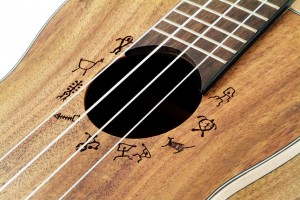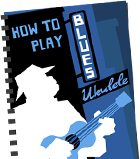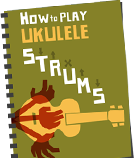Arranging tunes for the ukulele is obviously a subject close to my heart so when Michael (who you may know as LStrachey and reyalpEleluku on YouTube) asked me to look over the draft of his book Make Your Own Chord Solos I jumped at the chance. It’s now available and it’s an excellent little guide to the process and well worth looking at if you want to start making your own arrangements. I asked Michael a for a few pointers on arranging for ukulele.
What is your number one tip for creating ukulele chord solos?
Number one for me is: The notes of a tune are usually contained in the chords. For example, suppose a ‘C’ chord is the chord for a section of a tune. Play the chord one string at a time. On a ukulele, this chord will give you three different notes (ok, four different notes if you count the low and high C notes as ‘different’). It is very likely that this section of the tune consists of some or other of these notes from the C chord. For each note in that section of the tune, aim to play that C chord in such a way as to emphasise (in the correct order and time) the melody notes of the tune.
This is why I’ve included in my little book a page that gives tabs for all the notes of all the strings of a ukulele that is tuned G C E A. I’ve also included a number of pages that give a few different forms of selected chords. For each of these chords, I’ve shown the notes on each string in note form and tab form. I’ve also provided the chord diagrams as well.
For someone who has never arranged a tune before, what’s the best way to start
My advice would be to start with a simple tune that you know very well. Use only a few chords, and use single notes between chords to fill out the tune.
One of the first tunes I arranged was a real oldie by Harry Akst (1925). There are all sorts of wonderful jazz chords that might be used to play it. I just use two forms of the F chord and two forms of the C7 chord with a bit of fiddling in between. If you know the tune, you’ll recognise ‘Dinah’ when I play it.
After I could play Dinah easily, I found that I had a head-start for other tunes with similar chords. I could transfer techniques that I learned arranging ‘Dinah’ to make an arrangement of ‘Whoopee’ (a more modern tune from 1928).
How much music theory do you need to know to start arranging?
It depends. If you have natural talent, genius and perseverance, you don’t need any. Some great musicians knew/know little formal music theory. The great vaudeville ukulele instrumentalist, Roy Smeck, only learned to read music after his professional performing days had ended. He only did it so he could begin teaching.
Ok, if (like me) you are to start with nothing but perseverance, I’d say you’d need to know what standard musical notation looks like and have some idea what each bit means. Stuff like key signatures, the different durations of notes/rests, sharps, flats, accidentals, repeat signs, etc.
This might seem like a lot to know, but some of this is not needed if you know the tune – the timing and the duration of the notes are in your head already. Other parts of the theory can be side-stepped for a beginning arranger if you happen to have a page that gives tabs for all the notes of all the strings of a ukulele. With such a device you can see where a G# (for example) can be played, without necessarily knowing that it is a G#.
In my little book, I’ve explained the basics of music theory simply in only six pages – and there is lots of white space.
What’s the biggest challenge in making chord solos and how do you overcome it?
For me, the ‘big challenge’ changes from tune to tune.
Sometimes it is working out which key to play the song in. I had given up on the old standard ‘It had to be you’ (1924), because I couldn’t see how to play it comfortably in the key of G. Then, one day, I thought – try transposing the tune to another key – Bb – which met with almost immediate happiness.
Other times it is getting my hands to do what I’ve written in the tabs. When faced with this, I either practise till my family petition to have ‘ukulele playing’ made a capital offence, or I modify what was written in the tabs (after all, it was only me who put them there). If I like a tune and play it often, I notice that my way of playing it develops (mutates?) over time.
How can people get hold of your book?
I sell my book as a hobbyist, and information about the book (and how to buy it) may be found here: The Backwards Ukulele Player
I ask $16 (Australian dollars) for the book, plus postage and handling. P&H to UK, USA, and Canada works out at $9 (Australian dollars) – for other places, please ask.





